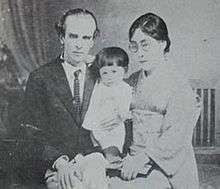Nikolai Aleksandrovich Nevsky

Nikolai Aleksandrovich Nevsky (Russian: Никола́й Алекса́ндрович Не́вский; the surname is also transcribed Nevskij; March 1 [O.S. February 18] 1892, Yaroslavl - 24 November 1937, Leningrad) was a Russian and Soviet linguist, an expert on a number of East Asian languages. He was one of the founders of the modern study of the Tangut language of the mediaeval Xi Xia Empire, the work for which he was awarded the degree of Doctor of Science in Philology during his life, and Lenin Prize posthumously. He spent most of his research career in Japan before returning to the USSR. He was arrested and executed during the Great Purge; his surviving manuscripts were published much later, starting in 1960.
Biography
Nikolai Nevsky, graduated from Rybinsk Gymnasium in 1909 with a "silver medal" (the second class of distinction), and entered the St Petersburg Institute of Technology. However, after a year he transferred to the Department of Oriental Languages of the Saint Petersburg University, from which he graduated in 1914. Among his teachers were Vasiliy Mikhaylovich Alekseyev and Aleksei Ivanovich Ivanov. In 1915 N.A. Nevsky was sent to Japan for two years, but due to the revolution and Russian Civil War he ended up staying remained in Japan for a much longer time.
While living in Japan, N.A. Nevsky traveled around the country, studying the language and customs of the Ainu, Miyako, and the Tsou people of Taiwan (then a part of the Japanese Empire). He published a number of research articles in Japanese journals.
He started learning the Miyako dialect from a student named Ueunten Kenpu, who entered Tokyo Higher Normal School in 1919. He visited the Miyako Islands in 1922, 1926 and 1928. He invented a Cyrillization of Miyako, recorded Miyako's epic songs called āgu, and left an unpublished Miyako lexicon.[1]
In 1925, Nevsky began work on the deciphering of Tangut language manuscripts, which had been discovered in 1909 in Khara-Khoto by Pyotr Kozlov.
In the autumn 1929, persuaded by Soviet scholars and officials, Nevsky moved from Japan to Leningrad. There he worked at the Leningrad State University, LIFLI (Leningrad Institute of Philosophy, Literature and History; Институт философии, литературы и истории), the Institute of Oriental Studies (then based in Leningrad), and the Hermitage Museum. In January 1935 he was awarded a Doctor of Science degree based on the sum of his work, without submitting a thesis.
On the night of 3 / 4 Oct, 1937 N.A. Nevsky was arrested by the NKVD on the charge of being a Japanese spy.[2] On November 24, 1937 he was executed, along with his wife, I. Mantani-Nevsky (Исо (Исоко) Мантани-Невская, 萬谷イソ, 萬谷磯子, 1901–1937). Their daughter Yelena was brought up by N. I. Konrad.
N.A. Nevsky was posthumously acquitted in 1957, and in 1962 he was posthumously awarded the Lenin Prize for the book "Tangut Philology", which was published in 1960 based on some of his surviving materials on the Tangut language. His other surviving manuscripts continued to be published, but many of his materials appear to be irretrievably lost.
Works by N.A. Nevsky
- Колпакчи Е.М., Невский Н.А. Начальный учебник японского разговорного языка. Л., 1933. 128 стр. 500 экз.// Kolpakchi E.M., Nevskiy N.A. Introductory course of spoken Japanese. Leningrad, 1933. 128 p. 500 copies.
- Колпакчи Е.М., Невский Н.А. Японский язык. Начальный курс. Л., 1934. 232 стр. Kolpakchi E.M., Nevskiy N.A. Japanese language: Introductory Course, Leningrad, 1934. 232 p.
- Материалы по говорам языка цоу. М.-Л., Изд-во АН. 1935. 134 стр. 1000 экз. Materials on the Tsou dialects. Moscow-Leningrad, Academy of Sciences Publishing House. 1935. 134 p. 1000 copies.
- Тангутская филология. Исследования и словарь. В 2 кн. М., ИВЛ. 1960. 1000 экз. Кн.1. Исследования. Тангутский словарь. Тетради I-III. 602 стр. Кн.2. Тангутский словарь. Тетради IV-VIII. 684 стр. // Tangut philology. Research and dictionary. In two volumes. Moscow, Oriental Literature Publishing House, 1960. 1000 copies. Volume One: Research. Tangut Dictionary. (Notebooks I-III). 602 pp. Volume Two, Tangut Dictionary. (Notebooks IV-VIII). 684 p.
- Айнский фольклор. / Исследования, тексты и пер. М., Наука. 1972. 175 стр. 2000 экз. * The Ainu Folklore: Research, Texts, and Translagtions. Moscow, Nauka Publishers. 1972. 175 pages 2000 copies.
- Фольклор островов Мияко. М., Наука. 1978. 192 стр. 7000 экз.// The Folklore of the Miyako Islands''. Moscow, Nauka Publishers. 1978. 192 pages 7000 copies.
- Материалы по говорам языка цоу; Словарь диалекта северных цоу. М., Наука. 1981. 292 стр. 950 экз. Materials on the Tsou dialects; A Dictionary of the Northern Tsou Dialect'. Moscow, Nauka Publishers. 1981. 292 p. 950 copies.
Works about Nevsky
- Громковская Л. Л., Кычанов Е. И. Николай Александрович Невский. (Серия «Русские востоковеды и путешественники»). М., Наука (ГРВЛ). 1978. 216 стр. Тираж: 10000 экз. L. Gromkovskaya, E.I Kychanov. Nikolai Aleksandrovich Nevsky. Moscow, Nauka Publishers. 1978. 216 pages. 10000 copies.
- На стёклах вечности… Николай Невский. Переводы, исследования, материалы к биографии // Петербургское востоковедение. Выпуск 8. СПб., Центр «Петербургское востоковедение», 1996. С. 239—560. ISBN 5-85803-077-7 (вып. 8) ISSN 0869-8392 Тираж: 1000 экз. The Windows of Eternity... Nikolai Nevsky // St. Petersburg Journal of Oriental Studies. Volume 8. St. Petersburg, St. Petersburg Centre for Oriental Studies. 1996. pp. 239–560. 1000 copies.
References
- ↑ Karimata Shigehisa 狩俣繁久 (1998). "Miyako kenkyū no senkusha 宮古研究の先駆者". In Nikolai A. Nevsky and L. L. Gromkovskaya. Miyako no fōkuroa 宮古のフォークロア (in Japanese).
- ↑ http://classic-web.archive.org/web/20120322023051/http://admin.russkiymir.ru/russkiymir/ru/magazines/archive/2008/04/article14.html?print=true
External links
- N.A. Nevsky - on the site of the Institute of Oriental Manuscripts (former St Petersburg Branch of the Institute of Oriental Studies) (Russian) (main source)